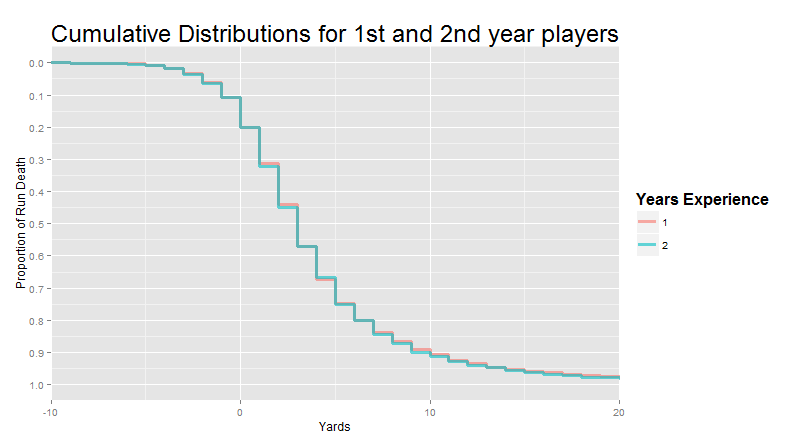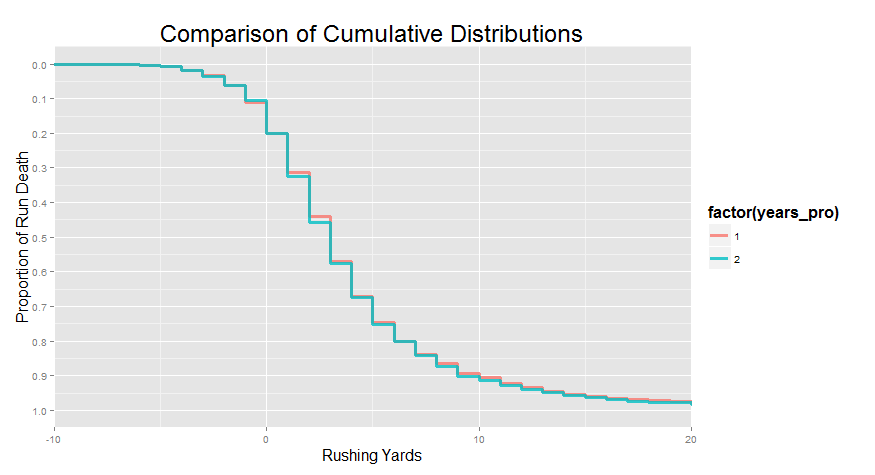I saw elsewhere on the internet that, on average, college players (at Mich) don’t actually tend to improve their yards per carry as they gain game experience. This analysis had some pretty obvious limitations, so I thought that perhaps our emphasis on run distributions could shine some light on the subject at the pro level: how does the run distribution change between a player’s first and second year in the league?
This is actually a bit more complicated than it sounds. For starters, we want to make sure we aren’t impacted by “survivor bias”. Say 5 new players enter the league, and as rookies they all get 50 carries. Then, 4 of them suck so bad they get cut, but the 5th one was really good, so he gets 250 carries the following year. Now, we can make a run distribution for first-year players and second-year players. But we’re actually comparing apples to oranges: we’re comparing 80% “bad players” to one “good player”. In other words, year 2 would look better because only the ones that were any good “survived” to year 2.
So what I did was restrict my analysis to all players who have carries in BOTH their first and second years, so we can look at the growth of the same players across years. Finding these players turned out to be easier if I limited the analysis to active players only (though I included folks that were rookies going back to 2011). In the end, I got about 10,000 carries evenly split between these player’s first and second years (and both years had the same players, overall).
Here’s what changed:

Oddly, nothing really seemed to change much at all. This actually appears to reach the same conclusion: experience didn’t seem to change much.
So I decided to explore a little more deeply. Just to make sure I wasn’t acidentally “filtering” for the “good” players by only including active players, I redid the analysis for all players that had at least 1 rookie carry and at least 1 sophomore carry between 2010 and 2015, regardless of whether or not they are still active. This bumped up our sample size to about 13,000 carries, almost evenly split between 1st and 2nd years. Here’s what I found:

Pretty much the same exact thing, if not slightly worse in year 2.
Next, I collapsed across players to get a sense for how the average 1st year player looks compared to the average 2nd year player on other metrics. A few things did change. Between a players 1st and 2nd years (for the average running back that lasted at least 2 seasons betwen 2010 and 2015):
- Average share of the passing game increased from 19.5 targets to 24.6 targets.
- Games started increased from 3 to 4.
- Games played increased from 12.0 to 12.2
BUT ALSO:
- Rushing attempts decreased from 96 to 93.
- Percent of team RB carries decreased from 35.7% to 33.6%.
- Yards per Carry decreased from 4.05 to 3.94.
These differences are slight, and may not be indicative of the NFL in general (i.e. it could be biased by the particular players in the league between 2010 and 2015). But in the very least, there is no evidence at all that 2nd-year running backs improve their abilities as a runner, and there is some tentative evidence that they may get slightly worse falling forward in the contested yards. What does change the most is the player’s role in the team. They are more likely to take a greater share of the passing game, and more likely to be designated as the starting running back (even if volume stays pretty much the same, and may even decrease slightly, on average).
One possibility here is that guys don’t really get much better, on average, at gaining yards. It’s hard to go pro - these guys hopefully know how to run when they get there. Their focus could be more devoted to learning offensive systems and schemes, settling into a rhythm with the QB and O-Line, improving their blocking, and learning the playbook (perhaps with some extra route running).
Another is that some running backs imrove for systematic (and potentially predictable) resasons, while other regress. Exploring this is a bit beyond the scope of this quick-hit. But here are the running backs that appeared to really improve from year 1 to 2: Alfred Blue, C.J. Spiller, Charles Sims, Eddie Lacy, Kendall Hunter, Le’Veon Bell, Ryan Mathews, Toby Gerhart. And here are the running backs that appeared to really regress: Andre Ellington, Bernard Pierce, DeMarco Murray, Doug Martin, Jeremy Hill, LeGarrette Blount, Stevan Ridley, Tre Mason, Trent Richardson. If there’s a pattern there, it’s not one that’s immediately obvious to me. Could be random! We don’t know!
Either way, this kinda surprised me. Rookies in most other sports tend to show improvement in most (or many) of the essential skills. It’s possible that gaining yards on the ground just isn’t one of them.